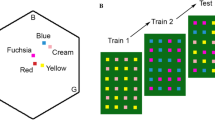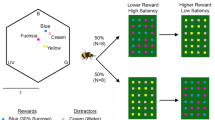Abstract
Psychophysicists studying decision making in animals have overwhelmingly focused on choice accuracy, not speed. Results from human visual search, however, show that there might be a tight link between the two. Here we review both visual-sensory and cognitive mechanisms that affect decision speed in flower visiting bees. We show that decision times are affected by contrast of targets and background, by similarity between targets and distractors, numbers of distractors present in a scene, illuminating light intensity, presence or absence of punishment, and complexity of tasks. We explore between-individual and within-individual speed-accuracy tradeoffs, and show that bees resort to highly dynamic strategies when solving visual search tasks. Where possible, we attempt to link the observed search behaviour to the temporal and spatial properties of neuronal circuits underlying visual object detection. We demonstrate that natural foraging speed may not only be limited by factors such as food item density, flight energetics and scramble competition, as often implied. Our results show that understanding the behavioural ecology of foraging can substantially gain from knowledge about mechanisms of visual information processing.







Similar content being viewed by others
References
Autrum HJ, Stoecker M (1950) Die Verschmelzungsfrequenzen des Bienenauges. Zeitschrift fuer Naturforschung 5:38–43
Boisvert MJ, Sherry DF (2006) Interval timing by an invertebrate, the bumble bee Bombus impatiens. Curr Biol 16:1636–1640
Briscoe AD, Chittka L (2001) The evolution of color vision in insects. Annu Rev Entomol 46:471–510
Burns JG (2005) Impulsive bees forage better: the advantage of quick, sometimes inaccurate foraging decisions. Anim Behav 70:e1–e5
Chittka L, Beier W, Hertel H, Steinmann E, Menzel R (1992) Opponent colour coding is a universal strategy to evaluate the photoreceptor inputs in hymenoptera. J Comp Physiol A 170:545–563
Chittka L, Brockmann A (2005) Perception space, the final frontier. PLoS Biol 3:545–549
Chittka L, Dyer AG, Bock F, Dornhaus A (2003) Bees trade off foraging speed for accuracy. Nature 424:388
Chittka L, Shmida A, Troje N, Menzel R (1994) Ultraviolet as a component of flower reflections, and the colour perception of hymenoptera. Vision Res 34:1489–1508
Chittka L, Thomson JD (1997) Sensori-motor learning and its relevance for task specialization in bumble bees. Behav Ecol Sociobiol 41:385–398
Chittka L, Thomson JD, Waser NM (1999) Flower constancy, insect psychology, and plant evolution. Naturwissenschaften 86:361–377
Collett TS, Fry SN, Wehner R (1993) Sequence learning by honeybees. J Comp Physiol A 172:693–706
Desimone R (1998) Visual attention mediated by biased competition in extrastriate visual cortex. Philos Trans Royal Soc B 353:1245–1255
Downing CJ, Pinker S (1985) The spatial structure of visual attention. In: Posner MJ, Martin OSM (eds) Attention and performance, vol 11. Lawrence Erlbaum Assoc., Hillsdale, pp 171–187
Dyer AG, Chittka L (2004a) Bumblebee search time without ultraviolet light. J Exp Biol 207:1683–1688
Dyer AG, Chittka L (2004b) Bumblebees (Bombus terrestris) sacrifice foraging speed to solve difficult colour discrimination tasks. J Comp Physiol A 190:759–763
Dyer A, Neumeyer C, Chittka L (2005) Honeybee (Apis mellifera) vision can discriminate between and recognise images of human faces. J Exp Biol 208:4709–4714
Giurfa M (2003) The amazing mini-brain: lessons from the honeybee. Bee World 84:5–18
Giurfa M, Lehrer M (2001) Honeybee vision and floral displays: from detection to close-up recognition. In: Chittka L, Thomson JD (eds) Cognitive ecology of pollination. University Press, Cambridge, pp 61–82
Gould JL (1985) How bees remember flower shapes. Science 227:1492–1494
Horridge A (2000) Seven experiments on pattern vision of the honeybee, with a model. Vision Res 40:2589–2603
Jander U, Jander R (2002) Allometry and resolution of bee eyes (Apoidea). Arthropod Struct Develop 30:179–193
Kemp DJ (2002) Visual mate-searching behaviour in the evening brown butterfly, Melanitis leda (L.) (Lepidoptera: Nymphalidae). Austr J Entomol 41:300–305
Kirschfeld K (1994) Tracking of small objects in front of a textured background by insects and vertebrates: Phenomena and neuronal basis. Biol Cybernet 70:407–415
Land MF (1999) Compound eye structure: matching eye to environment. In: Archer SNEA (ed) Adaptive mechanisms in the ecology of vision. Kluwer Academic Publishers, Dordrecht, pp 51–71
Laughlin SB (1989) The role of sensory adaptation in the retina. J Exp Biol 146:39–62
Lotto RB, Chittka L (2005) Seeing the light: Illumination as a contextual cue to color choice behavior in bumblebees. Proc Natl Acad Sci USA 102:3852–3856
McElree B, Carrasco M (1999) The temporal dynamics of visual search: Evidence for parallel processing in feature and conjunction searches. J Exp Psychol Human Percept Perform 25:1517–1539
Menzel R (2001) Behavioral and neural mechanisms of learning and memory as determinants of flower constancy. In: Chittka L, Thomson JD (eds) Cognitive ecology of pollination. University Press, Cambridge, pp 21–40
Nakayama K, Silverman GH (1986) Serial and parallel processing of visual feature conjunctions. Nature 320:264–265
Peitsch D, Fietz A, Hertel H, de Souza J, Ventura DF, Menzel R (1992) The spectral input systems of hymenopteran insects and their receptor-based colour vision. J Comp Physiol A 170:23–40
Raine NE, Ings TC, Dornhaus A, Saleh N, Chittka L (2006) Adaptation, chance, and history in the evolution of bee foraging behavior. Adv Study Behav 36:305–354
Saleh N, Ohashi K, Thomson JD, Chittka L (2006) Facultative use of repellent scent marking in foraging bumblebees: complex versus simple flowers. Anim Behav 71:847–854
Skorupski P, Chittka L (2006) Animal cognition: an insect’s sense of time? Curr Biol 16:R851–R853
Spaethe J, Chittka L (2003) Interindividual variation of eye optics and single object resolution in bumblebees. J Exp Biol 206:3447–3453
Spaethe J, Tautz J, Chittka L (2001) Visual constraints in foraging bumblebees: flower size and color affect search time and flight behavior. Proc Natl Acad Sci USA 98: 3898–3903
Spaethe J, Tautz J, Chittka L (2006) Do honeybees detect colour targets using serial or parallel visual search? J Exp Biol 209:987–993
Srinivasan MV, Lehrer M (1984) Temporal acuity of honeybee vision: behavioural studies using moving stimuli. J Comp Physiol A 155:297–312
Srinivasan MV, Zhang SW, Rolfe B (1993) Pattern vision in insects: “Cortical” Processing? Nature 362:539–540
Treismann A, Gormican S (1988) Feature analysis in early vision: evidence from search asymmetries. Psychol Rev 95:15–48
Vorobyev M, Brandt R, Peitsch D, Laughlin SB, Menzel R (2001) Colour thresholds and receptor noise: behaviour and physiology compared. Vision Res 41:639–653
Warrant EJ, McIntyre PD (1993) Arthropod eye design and the physical limits to spatial resolving power. Progr Neurobiol 40:413–461
Williamson SJ, Cummins HZ (1983) Light and color in nature and art. Wiley, New York
Wolfe JM (1999) How do you pay attention? Nature 400:813–815
Wolfe J (2000) Visual attention. In: DeValois KK (ed) Seeing. Academic Press, San Diego
Zenger B, Fahle M (1997) Missed targets are more frequent than false alarms: a model for error rates in visual search. J Exp Psychol 23:1783–1791
Author information
Authors and Affiliations
Corresponding author
Additional information
Handling Editor: Heikki Hokkanen
Rights and permissions
About this article
Cite this article
Chittka, L., Spaethe, J. Visual search and the importance of time in complex decision making by bees. Arthropod-Plant Interactions 1, 37–44 (2007). https://doi.org/10.1007/s11829-007-9001-8
Received:
Accepted:
Published:
Issue Date:
DOI: https://doi.org/10.1007/s11829-007-9001-8




